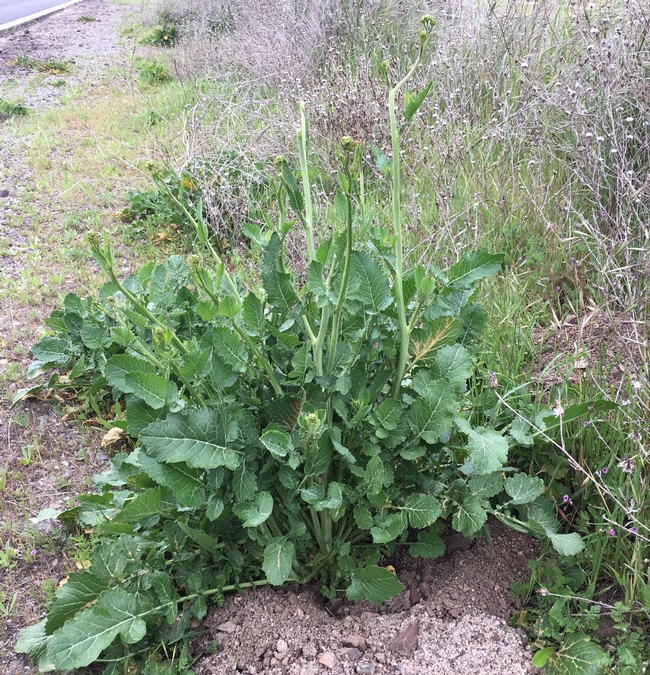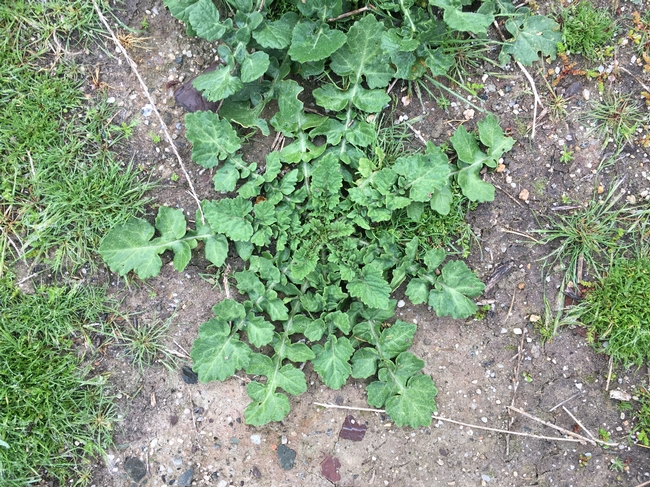- Author: Devii R. Rao
How to Control Mustard with Grazing
Summer mustard, sometimes also called short-pod mustard (Hirschfeldia incana) and black mustard (Brassica nigra) are common rangeland weeds on California's Central Coast. Summer mustard seems to be the more common species. It usually lives for two years or sometimes longer, can grow up to 4 feet tall, and has pale yellow flowers (DiTomaso, Kyser et al. 2013). Black mustard, on the other hand, is an annual plant and is taller (growing up to 6 feet tall), with flowers that are brighter yellow than summer mustard. DiTomaso, Kyser et al. (2013) noted that there has been no research on livestock grazing as a strategy to control summer mustard or black mustard. They suggested that grazing probably wouldn't be effective for summer mustard. But for black mustard, they remarked that large populations are more typically found on ungrazed or lightly grazed rangelands. Therefore, they speculated that grazing is probably effective for black mustard, especially since it is somewhat palatable to cattle.
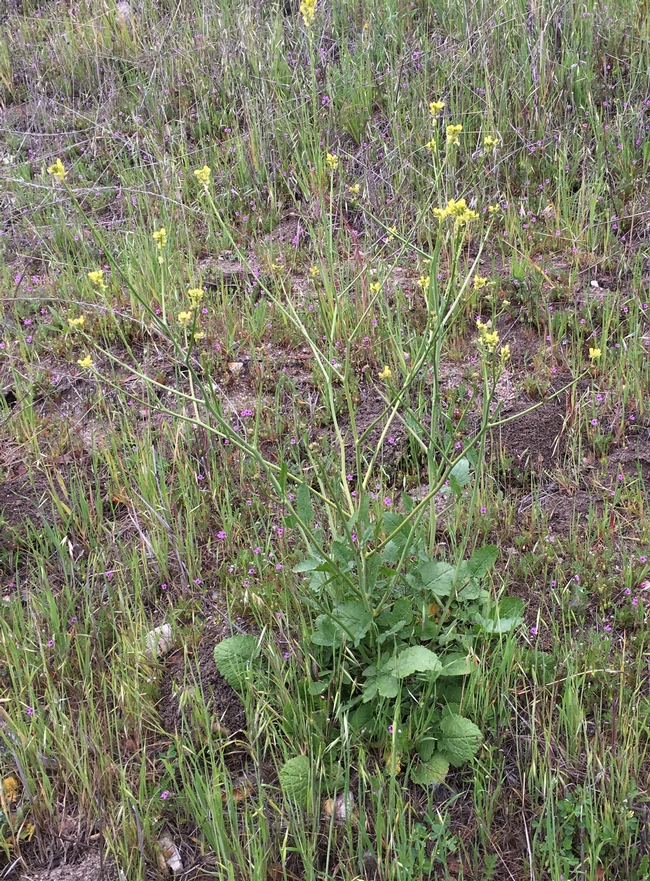
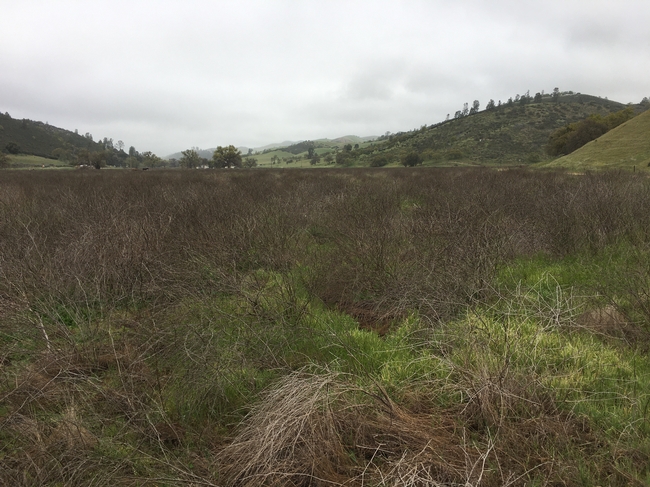
Royce Larsen is a UC Cooperative Extension Advisor in San Luis Obispo County. He has been testing forage quality of several common rangeland plants and is currently writing a publication based on his results. His unpublished data showed that during the height of the 2019 growing season crude protein (CP) for mustard was 19% (Larsen, pers. comm.). Mustard samples for his analysis contained roughly 90% summer mustard and 10% black mustard. Later in the 2019 season, in May after about 1.5 inches of rain, annual rangeland plants had dried up and rain had begun to leach out their nutrients. While mustard stems only had about 5% CP at that time, the plants were still green and had between 16%-22% CP in the leaves, flowers, and pods. This is similar to alfalfa, which contains about 20% CP (NASEM 2016). For comparison, during this same time of year (after May rains) Mr. Larsen's data showed that annual broad leaves had 14% CP and annual grasses only had about 3% CP. So, mustard leaves, flowers, and pods can be a valuable and palatable forage sources, especially late in the season when other plants have dried up.
Although, no scientific research has been conducted on controlling mustard with grazing, four ranchers in San Benito County have been keeping a close eye on how mustard responds to grazing. I had the pleasure of interviewing them to find out what they've learned over the years. Hopefully their observations will help you as you try to manage mustard on your property.
Allan Renz, Renz Livestock
Allan Renz, with Renz Livestock has experience grazing cattle on both black mustard and summer mustard, but primarily on black mustard. He has noticed that summer mustard is easier to control than black mustard because it's shorter (so cattle can eat it more easily) and stays green later in the season (it's the only green plant after the annuals have dried up). Allan has also observed that black mustard gets woodier than summer mustard and does so earlier in the season. This narrows the window that it can be grazed.
For both black mustard and summer mustard the best time to graze it is when it's bolting. February to early-March is the best time to start grazing because that's when large numbers of plants start bolting. At this stage it's green and more tender, so cattle are more likely to eat it. If you wait until the plant is flowering, cattle will still eat it, but once it starts flowering the seeds will begin developing so quickly that it's really too late. Cattle will eat mustard in the summer and fall as well, but it has already seeded by then, so even though cattle are eating the biomass of the plant, they are not reducing the next year's crop.
The size of the plant also influences it palatability. Allan's rule of thumb is that once the mustard stock is 1/8”, about the width of a No. 2 pencil, it's too late to graze. When it gets to this size, it's too woody for cattle to eat. But, cattle will still trample it at this stage and even when it's bigger. Trampling is good because you won't get 8-foot tall mustard. Tall mustard prevents sunlight from getting down to lower-statured plants like clover and filaree, so they are not able to grow. Trampling the mustard allows smaller plants to get more of the resources they need so they are able to grow.
Last spring Allan got a new lease that has mustard on it. This is only his second season grazing it. Cows started grazing the mustard field this year around March 19 and will be there until May 15. Since we had a lot rain recently, a lot of annuals are growing again and he wants to make sure to keep cattle in there to eat the foxtail.
At this site, there are 30 pairs on 60 acres. Allan does what he considers “heavy/overgrazing” for a limited amount of time to concentrate the animals and reduce the mustard flowers/seedbank. He said there weren't enough cows on the field to really control the mustard this year. So, Allan will mow certain portions of the fields before the mustard goes to seed, probably by around April 23. Not all cattle operations have access to a lot of machinery, but since Allan does, he uses it to his advantage.
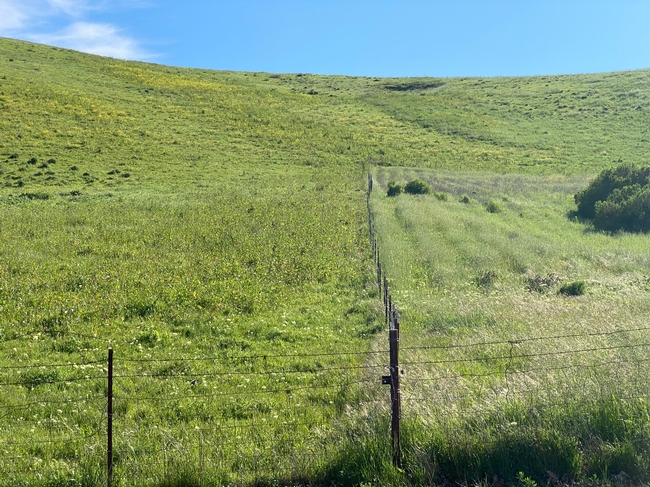
It can be challenging for a typical cow/calf producer to do targeted grazing on public lands for a couple reasons: 1) Agencies usually only want cattle to be on the property during the growing season, so the rancher needs to find another lease to put the cattle for the remainder of the year. 2) A cow/calf operator can't easily buy a lot of extra steers to put on a property for a short period of time when they are needed for weed control. The rancher has to use the cows he has. To address this second issue Allan uses double season steers and replacement heifers increase his livestock numbers on mustard properties. Double season steers refer to steers that are born late or small and are only 550 – 600 lbs. at the end of the season (as opposed to 750 which is preferable). He'll keep them on the ranch through the next year and graze them for a second green season, then sell them at around 1,000 lbs.
In order to effectively use his cattle for weed control on public lands, he needs to have several pastures on each property so he has the flexibility to concentrate the animals when needed or spread them out when needed. He also needs to have additional leases, including some that allow for summer use so has a place to graze his cattle in summer and so he can ramp up his cattle numbers when needed for mustard control.
Joe Morris, Morris Grassfed
Joe Morris, owner of MorrisGrassfed, doesn't think of weeds in the way most ranchers do, as a problem that you need to get rid of. Instead, his perspective is that every plant has its place and performs a function. Joe's strategy is to, “graze cattle in ways that increases biodiversity. This strategy produces more profit and does not encourage one to become fixated on weeds as a problem and spend money in ineffective ways…The mustards add to the biodiversity of the range, are great for pollinators, have a tap root that breaks up compact soils and drive carbon deep into the soil, and they provide forage and energy for the cattle who do the work of maintaining the rangeland community and thus money for the rancher.”
However, one of the properties Joe grazes is Hollister Hills State Vehicular Recreation Area (HHSVRA) where agency staff are trying to control weeds, primarily yellow starthistle. So, at that property Joe needs to focus on grazing for weed control. At HHSVRA, Joe mostly sees mustard in areas with high nitrogen, in heavy impact areas, and on slides. He has noticed that based on his grazing strategy to control yellow starthistle, mustard has been reduced as well. Joe observed 10-ft high mustard when he first started grazing at HHSVRA. Now he said it's not a big issue. Joe says you need to have high stock densities for cattle to eat mustard. He uses ½ million lbs./acre of animals. To put this into perspective, he says 1 million lbs./acre is about 800 cows (assuming they weigh 1,200 lbs.), on an area the size of a football field. So, his ½ million lbs./acre is about 400 cows on the size of a football field. He described this as being not as many animals as in a crowded corral or alley way. Joe's stocking rate is 25 animal days/acre which is 25 animals for one day on an acre. For Joe, that translates to having the 400 cows in a one-acre paddock for an hour or less before he moves them to the next paddock. These high stocking densities force cattle to be less selective, so they eat everything. The cattle finished grazing at HHSVRA around March 20 this year. Because cattle have been eating mustard, the grasses have been given room to grow.
Liz Reikowski, Willow Creek Land and Cattle LLC
Liz Reikowski, from Willow Creek Land and Cattle LLC, is also a master's student at the University of Nevada, Reno. She's studying natural resources and environmental science. Liz has experience grazing horses on summer mustard and cattle on black mustard.
At Liz's home ranch, she has an 8-acre horse pasture that used to have 90% cover of summer mustard, but now it's down to about 2% cover. She grazes 4 horses on the pasture in spring. The horses are turned out onto the pasture when the grass is 6-8 inches. She rotates the horses through several 1-acre paddocks. The 4 horses are in each paddock for roughly 1 week, although the amount of time varies by year. In summer, the horses come off the horse pasture and graze on 70 acres of oak woodland on neighbor's property. Liz says it's really important to rest the pasture in the dormant season. Once the horses graze down the 70 acres they are moved to a corral until the next grazing season. Liz says the best time to graze is when the summer mustard is bolting. When it's flowering, it gets coarse and horses don't like to eat it. When mustard is the same height or a little taller than the grass, horses will eat it. But, when mustard is in the rosette stage or when it's taller than the grass, horses won't eat it.
Before Liz began rotating the horses, they had access to the full 8 acres. They ate what they liked and avoided what they didn't like. She noticed that after she shifted to a rotational strategy, the horses were forced to eat things they didn't necessarily prefer. That reduced the competitive advantage of weed species and allowed for more palatable species to compete better. Even with rotating the animals, the horses don't eat a lot of mustard. They mostly eat it by accident. But, they do trample it. Trampling helps to decrease the height of mustard, which allows more sun to reach smaller, more palatable plants and help them grow.
Liz uses cattle to graze black mustard on a private lease near her home ranch. The property is about 200 acres, but the mustard in mainly in a 4.5-acre paddock. Cattle are on the property in fall, winter, and spring. In the mustard field, 22 head of bred heifers, weighing 900-1000 lbs. grazed for 5 days, from April 6 – April 10. They ate at least one bite of every mustard plant. These 5 days are the only time they'll be in the mustard field for the entire year. They will come back next spring. Liz has seen black mustard get 6-10 feet tall. In the rosette stage, mustard doesn't usually get eaten because cattle don't feed that low unless they are so stressed that they'll eat the paddock to the ground. Right now (mid-April) cattle are eating a lot of mustard. It's at the beginning of bolting stage, about 3-4 feet tall. Surprisingly, when cattle were let into the paddock with the black mustard, they ran to the mustard patch, even though there was plenty of green grass in the field. This year is only the second year Liz has been grazing that field and she hasn't observed any changes yet.
Jeff Mundell, Rancho Cienega del Gabilan/Gabilan Ranch
Jeff Mundell is the ranch manager for Rancho Cienega del Gabilan (Gabilan Ranch). The ranch has black mustard and probably also has summer mustard, but Jeff is most familiar with black mustard. Over past 4 years Jeff has seen substantial reductions in the amount of mustard on the ranch. He usually sees black mustard in high traffic pastures and those with compacted soils or bare ground. He has noticed that mustard is the first plant to come in and cover bare ground with its rosettes.
If there's a large stand of mustard, it's not too palatable, so it's the last thing cattle eat in the pasture. Because of that, he stopped trying to graze the mustard and instead his goal is to trample it. Jeff uses about 400 head in 2-acre pastures for 24 hours to lay down the mustard. This allows other plants like grasses and clovers to, “come in and express themselves.” Jeff says that when you trample the mustard, it creates microclimate conditions that hold moisture and create a nice litter bed like in your garden. When mustard gets trampled and laid down on the ground, rain doesn't hit bare ground, so you don't have erosion issues. Microbes break down the mustard quickly, so new desirable plants come up. As a rancher, using cattle is the cheapest way for him to get desirable plants to come in. His goal is to reduce the mustard and get more grass to come in to put more pounds on cattle. Jeff says he's not against mustard, but he's against what mustard is telling him. The mustard is telling him that the ground is compacted or bare, so he needs to change his management so he can be more profitable.
One way to prevent compaction is to pay attention to when cattle are on wet soils. If you have mustard in a field that is wet and compactible in early spring, graze it in late-spring, after it has dried. If you graze mustard in late-spring, you only need to graze the paddock once. However, if you are able to graze a mustard field in the early spring, then you can go back to the field in the dormant season. He explained that if mustard is grazed/trampled early in the season, and there's enough soil moisture and sunshine then good forage plants will have the ability and time to grow. That way you can return to the paddock in the dormant season and cattle can graze the forage plants that were able to grow. Jeff lamented that it feels like you're wasting feed the first time you use cattle to trample the mustard, but he said you are just deferring the feed value. You're leaving a lot of trampled and pooped on grass behind, but in the following year, and many years to come, you'll even better growth of the plants you want.
I am grateful to these ranchers for spending time and sharing their stories with me. Throughout the interviews a couple of ideas repeatedly came up: 1) graze mustard plants when are bolting and before flowering and 2) use a high stocking rate to force the animals to eat and trample mustard, which will allow other species to come up.
Over the years several land managers have asked me if grazing can be used to control mustard. I've always had to tell them that no research exists on the topic, but that it seems like grazed rangelands have less mustard than ungrazed rangelands. I'm now collaborating with Leslie Roche, UCCE Rangeland Science and Management Specialist at UC Davis, to develop an experiment that will hopefully begin to answer that question through research. Based on my interviews with these four ranchers, controlling mustard with grazing seems like a promising strategy.
I'd like to leave you with a quote from Jeff Mundell: “The more we can figure out how to use cattle for weed control, the more the public will see ranchers as an asset. People like to hire goats to come in and graze weeds. There's no reason cattle can't come in and do the same thing.”
References
DiTomaso, J.M., G.B. Kyser et al. 2013. Weed Control in Natural Areas in the Western United States. Weed Research and Information Center, University of California. 544 pp.
Larsen, R. 2020. Personal communication. Larsen is a Natural Resources and Watershed Advisor with University of California Cooperative Extension. He serves San Luis Obispo, Monterey, and Santa Barbara counties.
NASEM (National Academies of Sciences, Engineering, and Medicine). 2016. Nutrient requirements of beef cattle. Eighth Revised Edition. Washington, DC: The National Academies Press. Doi: 10.17226/19014.

